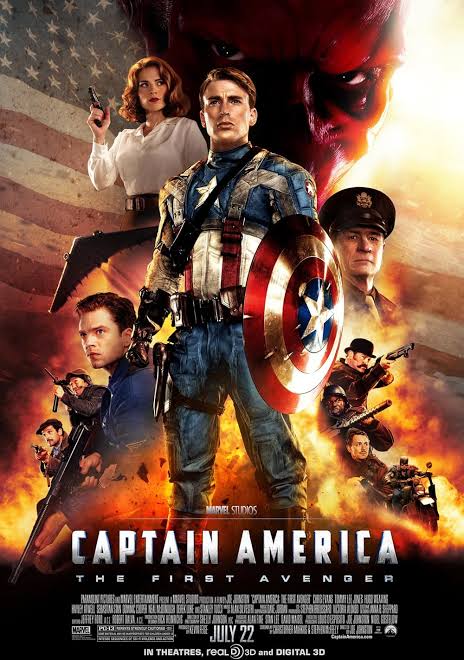Read the full movie review of Captain America: The First Avenger (2011) — a patriotic origin story set during WWII that introduces Steve Rogers and lays the foundation for Marvel’s Avengers. Find out how it holds up over a decade later.

Captain America: The First Avenger (2011) – Movie Review
Best Movie Review (BMR) Rating: 8/10
Genre: Superhero, Action, War, Sci-Fi
Director: Joe Johnston
Cast: Chris Evans, Hayley Atwell, Hugo Weaving, Sebastian Stan, Tommy Lee Jones, Dominic Cooper
Runtime: 2h 4m
Release Date: July 22, 2011
Language: English
Production Company: Marvel Studios
Streaming On: Disney+ Hotstar
Introduction
Captain America: The First Avenger is Marvel Studios’ bold leap into historical fiction, blending a WWII war drama with superhero spectacle. As the fifth installment in the Marvel Cinematic Universe (MCU), it introduces the iconic super-soldier Steve Rogers, played by Chris Evans, and sets the stage for The Avengers (2012). With its vintage aesthetic and heartfelt narrative, this film proves that sometimes the greatest strength lies not in power—but in character.
Plot Overview
The film begins in present day, where scientists discover a frozen aircraft with a mysterious red-white-and-blue shield. Flashback to 1942: Steve Rogers is a frail but determined young man in Brooklyn who repeatedly tries and fails to enlist in the U.S. Army.
Dr. Abraham Erskine (Stanley Tucci) sees something special in Steve and recruits him for a top-secret project—Operation Rebirth. Steve is injected with a super-serum that transforms him into the peak of human physicality: Captain America.
Meanwhile, the villainous Johann Schmidt aka Red Skull (Hugo Weaving), a Nazi officer and leader of Hydra, harnesses the power of the Tesseract—a cosmic cube with immense energy. Captain America, aided by Agent Peggy Carter (Hayley Atwell) and best friend Bucky Barnes (Sebastian Stan), must stop Red Skull and his army from reshaping the world in Hydra’s image.
Performances
Chris Evans delivers a sincere and nuanced performance as Steve Rogers. His portrayal of a kind-hearted underdog turned super-soldier is emotionally resonant and heroic without being arrogant.
Hayley Atwell as Peggy Carter is more than a love interest—she’s sharp, independent, and a standout in her own right. Their chemistry feels genuine and unforced.
Hugo Weaving gives Red Skull the gravitas and menace expected from a classic Marvel villain, though his character could have benefited from deeper development.
Sebastian Stan brings warmth to Bucky Barnes, while Tommy Lee Jones provides dry humor as Colonel Chester Phillips. Dominic Cooper’s Howard Stark offers a charismatic preview of Tony Stark’s legacy.
Direction & Cinematography
Joe Johnston brings his Rocketeer experience to the table, blending retro wartime visuals with comic-book flair. The film’s sepia-toned color palette and period detail make 1940s America feel authentic, while the action sequences stay grounded despite the superhero context.
The visual effects used to portray Steve Rogers’ transformation—from a scrawny recruit to a super-soldier—are impressive, even by today’s standards. The final scenes, particularly the aircraft sequence, are visually thrilling and emotionally charged.
Action & Visual Effects
The action is stylized and clean, avoiding the overly chaotic fight choreography seen in some modern superhero films. Captain America’s shield combat is cleverly choreographed, making full use of the character’s abilities.
Explosions, Tesseract-powered weapons, and a mix of classic and futuristic technology give the movie a unique retro-futuristic charm. Red Skull’s disintegration scene and the final aircraft crash are visually memorable moments.
Music & Sound
Alan Silvestri’s score is one of the MCU’s most iconic. The main Captain America theme exudes patriotism, heroism, and hope—perfectly capturing Steve Rogers’ journey. The background music amplifies both action and emotion, making the soundtrack one of the movie’s strong assets.
Writing & Pacing
The screenplay by Christopher Markus and Stephen McFeely is tight and emotionally effective. It balances origin story, action, and moral lessons without dragging.
The first half focuses on character-building, while the second half dives into war and superhero action. The film’s emotional core—Steve’s humility and sacrifice—is what truly sets it apart from other origin stories.
Connections to the MCU
The First Avenger plays a vital role in the MCU. It introduces the Tesseract, an Infinity Stone that becomes crucial in later phases. It also sets up Hydra, SHIELD’s roots, and seeds the future relationship between Steve and Bucky. The post-credit scene transitions directly into The Avengers (2012), officially uniting the timeline.
Strengths
- Powerful and sincere lead performance by Chris Evans
- Authentic 1940s setting and production design
- Strong emotional and moral core
- Iconic music score by Alan Silvestri
- Meaningful themes of sacrifice, honor, and courage
Weaknesses
- Red Skull lacks depth compared to later MCU villains
- Some montages feel rushed (especially Cap’s missions)
- Slightly predictable narrative for viewers familiar with comic lore
Conclusion
Captain America: The First Avenger is more than just an origin story—it’s a heartfelt war drama wrapped in superhero packaging. With a strong performance by Chris Evans, memorable music, and a tone that balances action and heart, this film proves that the true superpower is selflessness.
It doesn’t rely on visual spectacle alone—it tells a story of integrity, sacrifice, and enduring spirit. As the foundation for one of the MCU’s core Avengers, The First Avenger succeeds in delivering a classic, old-school hero for a modern cinematic universe.
BMR Rating: 8/10
A sincere, patriotic, and emotionally grounded superhero origin story that sets the tone for Marvel’s future greatness.